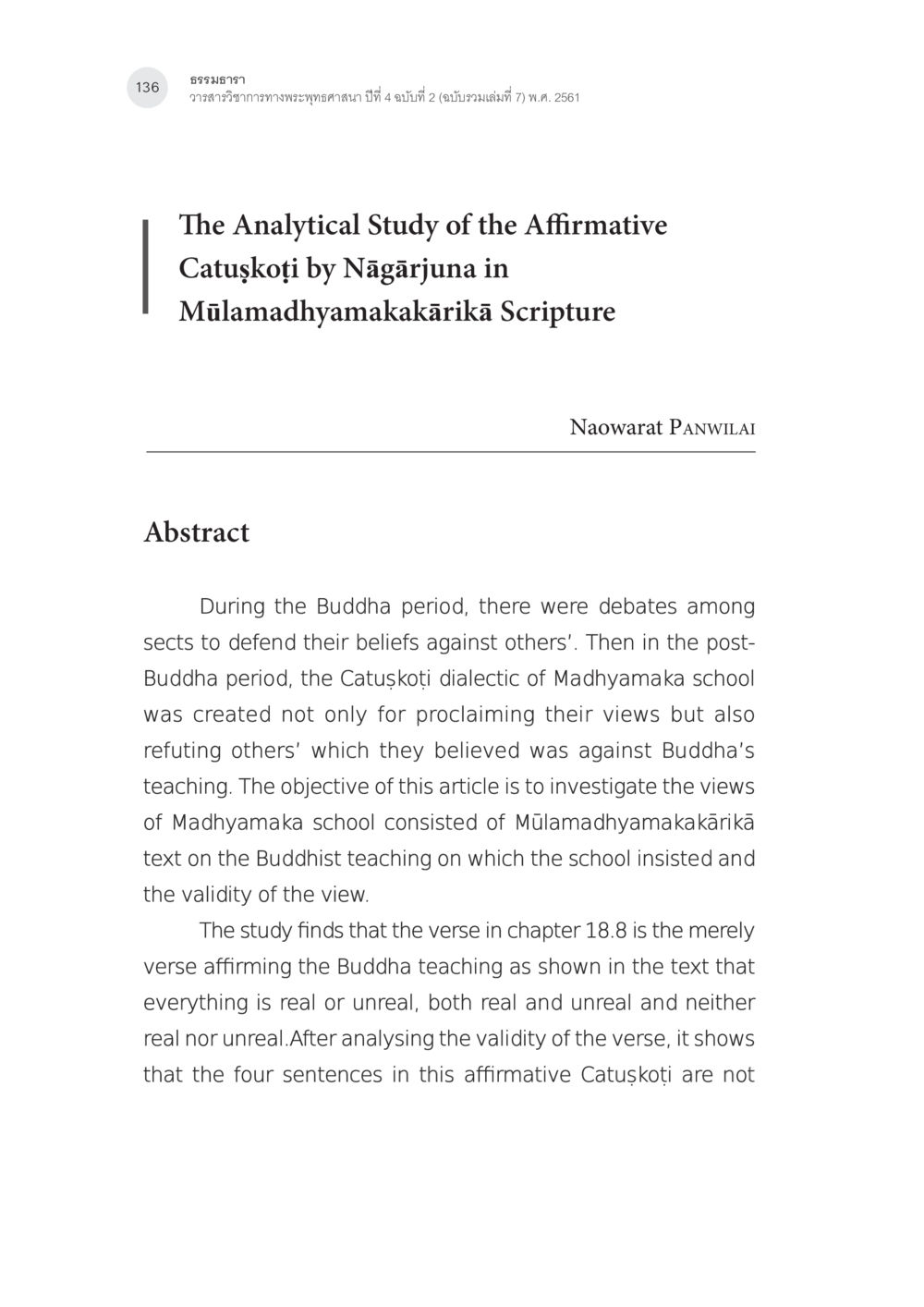การศึกษาวิเคราะห์ Catuṣkoṭi แห่ง Nāgasārjuna ในพระธรรมบท : หน้า 5/31
การศึกษาวิเคราะห์จตุษโกฏิประเภทยืนยันของพระนาคารชุนในคัมภีร์ มูลมัธยมกการิกา : หน้า 5/31 บทความวิจัยเกี่ยวกับ Catuṣkoṭi และความเชื่อในพระพุทธศาสนา สมัยหลังพุทธกาลจากงานเขียน Mūlamadhyamakakārikā
3 ครั้ง

สรุปเนื้อหา
บทความนี้สำรวจมุมมองของโรงเรียนมัธยมาคาในเรื่อง Catuṣkoṭi ซึ่งถูกสร้างขึ้นเพื่อการปกป้องและตอบโต้ความเชื่อที่ต่างกันในช่วงหลังพุทธกาล โดยเน้นการวิเคราะห์ทฤษฎีที่แสดงถึงสอนของพระพุทธเจ้า ตลอดจนความถูกต้องของมุมมอง ทั้งนี้การศึกษาได้พบว่าบทใน章 18.8 ยืนยันคำสอนที่ว่า ทุกสิ่งสามารถเป็นจริงหรือไม่จริง ทั้งยังเป็นทั้งจริงและไม่จริง รวมทั้งไม่เป็นทั้งจริงและไม่เป็นจริง การวิเคราะห์ความถูกต้องของประโยคนี้ชี้ให้เห็นถึงการสนับสนุนภายในความเชื่อทางพระพุทธศาสนา.
หัวข้อประเด็น
-Catuṣkoṭi
-madhyamaka
-ความเชื่อในพระพุทธศาสนา
-การวิเคราะห์พระธรรมบท
-Nāgasārjuna
ข้อความต้นฉบับในหน้า
136
ธรรมธารา
วาวสาววิชาการทางพระพุทธศาสนา ปีที่ 4 ฉบับที่ 2 (ฉบับรวมเล่มที่ 7) พ.ศ. 2561
The Analytical Study of the Affirmative Catuṣkoṭi by Nāgasārjuna in Mūlamadhyamakakārikā Scripture
Naowarat PANWILAI
Abstract
During the Buddha period, there were debates among sects to defend their beliefs against others’. Then in the post-Buddha period, the Catuṣkoṭi dialectic of Madhyamaka school was created not only for proclaiming their views but also refuting others’ which they believed was against Buddha’s teaching. The objective of this article is to investigate the views of Madhyamaka school consisted of Mūlamadhyamakakārikā text on the Buddhist teaching on which the school insisted and the validity of the view.
The study finds that the verse in chapter 18.8 is the merely verse affirming the Buddha teaching as shown in the text that everything is real or unreal, both real and unreal and neither real nor unreal. After analysing the validity of the verse, it shows that the four sentences in this affirmative Catuṣkoṭi are not
หนังสือที่เกี่ยวข้อง
Load More































